
Adelophryne is a genus of frogs in the family Eleutherodactylidae. They are native to northern South America east of the Andes, known roughly from the area corresponding to the Guiana Shield, as well as to the coastal area of Bahia, Brazil. Whether the genus is truly distinct from Phyzelaphryne remains uncertain. Common name shield frogs has been proposed for this genus, although the stem flea frog is used for some species.

Adenomera is a genus of leptodactylid frogs, sometimes known as tropical bullfrogs, found in South America east of the Andes. The genus was until recently considered a synonym of Leptodactylus.

Hyalinobatrachium is a genus of glass frogs, family Centrolenidae. They are widely distributed in the Americas, from tropical Mexico to southeastern Brazil and Argentina.

Hyloscirtus is a genus of Neotropical frogs in the family Hylidae. This genus was resurrected in 2005 following a major revision of the Hylidae, with the distinguishing features being 56 transformations in nuclear and mitochondrial proteins and ribosomal genes. Of these species, 28 species, previously placed in the genus Hyla, were moved to this genus. The fingers and toes of these frogs have wide dermal fringes.
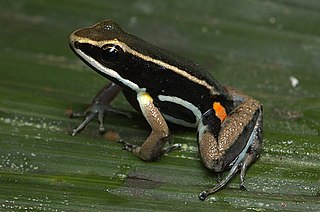
Allobates is a genus of frogs in the family Aromobatidae. They are native to the Central and South Americas, from Nicaragua to Bolivia and Brazil, with one species on Martinique.
Aromobates, sometimes known as the skunk frogs, is a genus of frogs from the Andes of Venezuela and Colombia. Originally a monotypic genus consisting of the skunk frog, Aromobates nocturnus alone, it was later expanded to include Nephelobates. These frogs are difficult to differentiate from Allobates without using molecular markers.

The Aromobatidae are a family of frogs native to Central and South America. They are sometimes referred to as cryptic forest frogs or cryptic poison frogs. They are the sister taxon of the Dendrobatidae, the poison dart frogs, but are not as toxic as most dendrobatids are.
Allobates pittieri is a species of frog in the family Aromobatidae. It is endemic to northern Venezuela where it is known from the Venezuelan Coastal Range and northeastern part of the Cordillera de Mérida. Its type locality is in the Henri Pittier National Park. The species is found in humid lowland to lower montane forest, usually very near rivers and streams where it breeds.
Mannophryne caquetio is a species of frog in the family Aromobatidae. It is endemic to Venezuela. Its natural habitats are subtropical or tropical moist lowland forest and rivers. It is threatened by habitat loss.
Mannophryne lamarcai is a species of frog in the family Aromobatidae. It is endemic to Venezuela and inhabits a narrow altitudinal band in the Ziruma mountains between the states of Zulia, Falcón and Lara. Its natural habitats are subtropical or tropical moist montane forest and rivers. It is threatened by habitat loss.

The yellow-throated frog, Trinidadian stream frog, Trinidad stream frog, or Trinidad poison frog is a species of frog in the family Aromobatidae that is endemic to the island of Trinidad in the Republic of Trinidad and Tobago. Mannophryne venezuelensis from the Paria Peninsula in Venezuela were formerly included in this species.
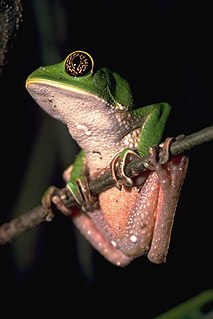
Phyllomedusa trinitatis is a species of frog in the family Phyllomedusidae. It is found in Trinidad and Tobago and Venezuela. Its natural habitats are subtropical or tropical moist lowland forests, subtropical or tropical moist montane forests, moist savanna, subtropical or tropical moist shrublands, freshwater marshes, heavily degraded former forests, ponds, and canals and ditches. It is threatened by habitat loss.
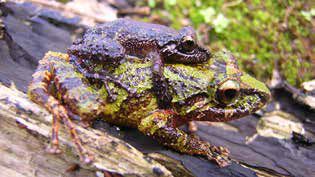
Pristimantis riveroi is a species of frog in the family Craugastoridae. It is endemic to Venezuela and only known from the region of the type locality in the Serranía del Litoral in the state of Aragua. The specific name riveroi honours Juan A. Rivero, a Puerto Rican herpetologist. Accordingly, common name Rivero's ground frog has been proposed for it.
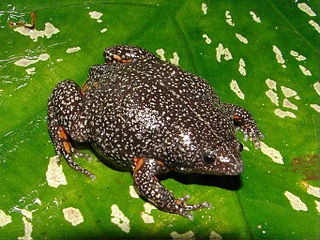
Elachistocleis pearsei is a species of frog in the family Microhylidae. It is found in the Caribbean drainage of Colombia and Panama and in northwest Venezuela.

Pristimantis is a very large genus of frogs distributed in the southern Caribbean and in Central and South America from Honduras to northern Argentina and southern Brazil. With 546 described species, Pristimantis had more species than any other genus of vertebrate animals. Many of these species genus are endemic to the Northwestern Andean montane forests ecoregion in northwestern South America.
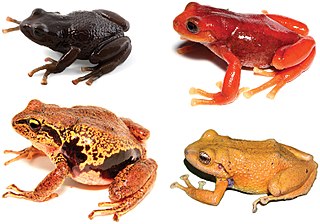
The Craugastoridae, or fleshbelly frogs, are a family of New World direct-developing frogs. As delineated here, following the Amphibian Species of the World, it is a large family containing 857 species. They are found from the southern United States southwards to Central and South America.

Aprada-tepui is a tepui in Bolívar state, Venezuela. It has an elevation of around 2,500 metres (8,200 ft) above sea level. It gives its name to the Aprada Massif, which also includes the smaller Araopán-tepui to the east. A steep, semi-circular ridge connects these two summits. Aprada-tepui lies 22 kilometres (14 mi) northwest of the much larger Chimantá Massif and around 25 km (16 mi) east of the Pemón village of Urimán.

Anomaloglossus is a genus of frogs in the family Aromobatidae. The genus is endemic to the Guiana Shield in northern South America. It used to be placed in the family Dendrobatidae, and is still placed in that family by some sources. The name of the genus, from the Greek anomalos and glossa (=tongue), refers to the unusual tongue bearing the median lingual process, the only unambiguous phenotypic synapomorphy of this genus.
Ceuthomantis is a small genus of craugastorid frogs, also treated as comprising their own monogeneric family Ceuthomantidae. They are found in the southern and eastern parts of the Guiana Highlands in Venezuela, Guyana, and Brazil. The generic name is derived from the Greek noun mantis, which means treefrog, and adjective keuthos, which means hidden, in allusion to the hidden existence of this genus in the tepuis of the Guiana Shield.

The Serranía del Empalado, also referred as serranía de Siruma or Ciruma, forms part of the system Coriano or Lara-Falcón-Yaracuy formation in Venezuela. It is a mountainous chain relatively high, small and isolated. It is separated of the Serranía of Jirajara, south, by lower heights to the 900m; of the Sierra of Baragua, to the east, by the Depression of Carora; and of the Sierra of Saint Luis by the valley of the river Matícora.














